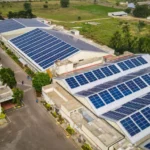India sits beneath a nearly endless sky of sunshine, giving it a natural edge for collecting solar energy. Acknowledging this gift, the Indian government rolled out the National Solar Mission (NSM), a key programme designed to harness that light. Since its launch, the NSM has spurred a remarkable increase in solar installations across the country within just ten years.
Anúncios
This article breaks down the National Solar Mission in plain terms. We look at its aims, work phases, the advantages it brings, and the wider support structure for solar energy in India. You’ll also find answers to frequently asked questions about India’s solar policies and what lies ahead for clean power.
What is the National Solar Mission?

The National Solar Mission — Jawaharlal Nehru National Solar Mission — introduced in January 2010, sits under India’s National Action Plan on Climate Change. Its cornerstone aim is to widen the use of solar energy while slowly cutting the nation’s reliance on coal and oil.
Anúncios
At first, the mission set a target of 20 gigawatts (GW) by 2022, but rapid technological advance and public enthusiasm soon pushed planners to raise that goal to 100 GW in 2015.
Also Read Picking the Right Solar Inverter for Your Indian Home
Why Was the Mission Launched?
India basks in roughly 300 sunny days each year, making it a natural site for solar power, yet before 2010 the country’s solar market was tiny. Prices were steep, and most electricity still came from coal or costly diesel generators.
The National Solar Mission was launched to:
Anúncios
- Expand clean, renewable energy use
- Cut carbon emissions nationwide
- Lower the cost of solar power
- Back home systems, business plants, and rural grids
- Create jobs in manufacturing panels and related tech
Main Targets of the National Solar Mission
The mission aimed to add 100 gigawatts of solar capacity by 2022 as part of a wider goal of 175 gigawatts that also includes wind, small hydro, and bio-energy. That 100-gigawatt slice breaks down into:
- 60 gigawatts from large grid-connected solar farms
- 40 gigawatts from rooftop installations on homes and offices
By pushing both big plants and small rooftop setups, the program sought to serve cities and villages alike, making solar easy and affordable for everyday Indians.
Three Phases of the National Solar Mission
Phase I (2010–2013)
This was a test run. Key goals were to:
- Encourage small off-grid installations
- Draft rules for rooftop and village units
- Build basic solar thermal plants
- Offer soft loans and cash grants
During these three years, about 1,000 megawatts went live.
Phase II (2013–2017)
Next, the aim was growth. The focus shifted to:
- Big utility farms
- City rooftop programs
- Huge solar parks with shared roads
- Reverse auctions that drove down bids
Output soared, adding over 12,000 megawatts.
Phase III (2017–2022)
Now the target was 100 gigawatts.
Goals included:
- Boosting local cell production
- Joining solar tightly with the national grid
- Backing storage and hybrid systems
Speedy progress placed India among the world’s top five solar nations.
Key Features of the National Solar Mission
Policy Support
Clear rules and steady backing lured private capital.
Subsidies and Incentives
Homeowners received financial help for rooftop panels.
Solar Parks
Vast sites were reserved, sharing roads, power links and land for fast, utility-scale plants.
Support for Rural Electrification
In many remote villages with no grid power, small solar lights and water pumps were installed.
Promotion of Domestic Manufacturing
Under the National Solar Mission, India backed its Make in India drive by funding local solar panel and inverter factories.
Involvement of SECI
The Solar Energy Corporation of India (SECI) was set up to run solar auctions and guide project roll-out.
Achievements of the National Solar Mission
- India crossed its original 20-gigawatt goal well before 2022
- By early 2024, more than 73 gigawatts of solar generation are now in place across the country
- Rooftop systems alone power over three million households nationwide
- Average tariffs have dropped from above 17 rupees a unit in 2010 to just 2–3 rupees today
- India also hosts some of the world’s biggest solar parks, including the vast Bhadla facility in Rajasthan
Challenges Faced
- Buying land for solar farms can be tough in crowded states
- The grid also struggles, often letting uneven supply spoil integration
- Most panels still come from China, which ties the market to imports
- Many village households simply do not yet see how solar helps them
Future of Solar Energy in India
By 2030, India wants 500 GW of non-fossil power, and sun energy will lead the way. Current policy spots four focus areas:
- Storage batteries
- Wind-solar hybrids
- Solar cars and chargers
- Fair access for every citizen
Frequently Asked Questions (FAQs)
Q1. What is the National Solar Mission?
Launched in 2010, it aims to boost solar use across the country.
Q2. What are the main goals of the NSM?
The mission wants 100 GW installed, cuts fossil use and makes clean power cheaper.
Q3. Who implements the NSM?
The Ministry of New and Renewable Energy and the Solar Energy Corporation of India run it.
Q4. What is the role of rooftop solar in the NSM?
Rooftops alone should add 40 GW toward the 100 GW goal.
Q5. Can homeowners apply for rooftop solar subsidies under the NSM?
Yes, homeowners can still tap central funds through MNRE’s rooftop solar plan.
Q6. How has the NSM impacted India’s solar sector?
The mission has lowered prices, pulled in worldwide capital and placed India among leading solar markets.
Conclusion
The National Solar Mission marked a big shift on India’s road to clean energy. It has made solar cheaper, raised public awareness and laid solid groundwork. Even with hurdles ahead, the country’s sun-power promise is unmatched.
If you plan to put panels on your roof, the NSM now makes the job easier and less costly than ever. Go ahead, switch to sunlight and watch your savings grow year after year.










